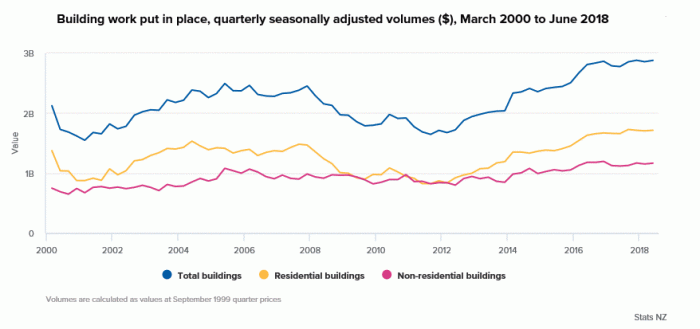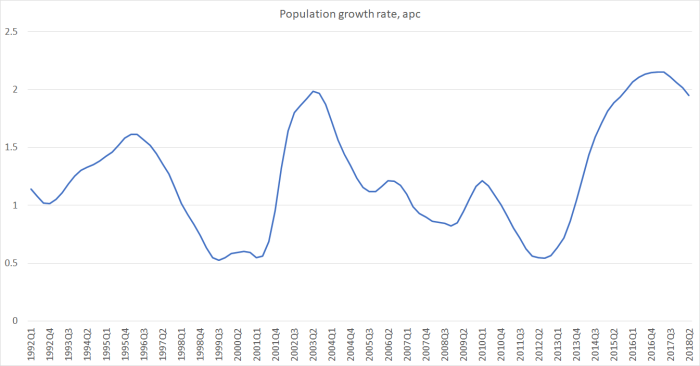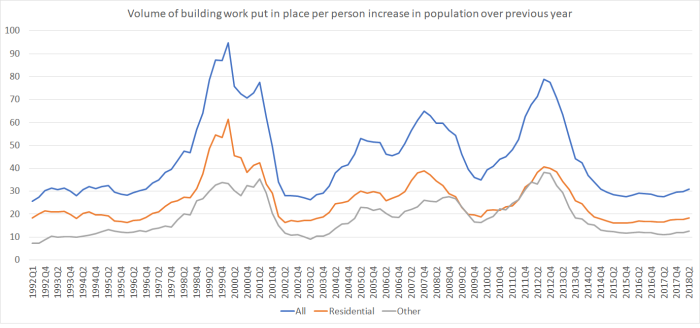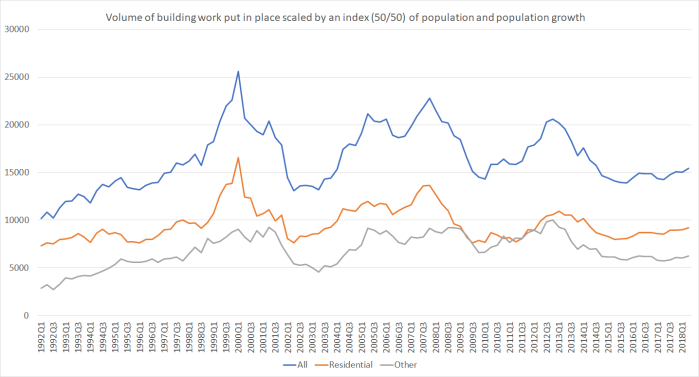Yesterday Statistics New Zealand released the quarterly data on building work put in place. The release included this chart.

SNZ like this sorts of chart, which tend to reinforce the relentlessly upbeat tone favoured by the department.
But most economic series reach new highs quite frequently, even volume measures. Real GDP, for example, is higher this year than it has ever been before, and almost all future years will be higher again. Knowing that doesn’t tell one much.
For a start, one usually wants to transform these series into per capita measures, particularly in a country whose population is growing relatively rapidly. New Zealand’s population, for example, has increased by just over 25 per cent since 2000, when that SNZ chart starts.
Here is the same data, over a longer run of time, in per capita terms.

In per capita terms, the volume of building work has been (a) pretty flat, and if anything falling back slightly, for the last couple of years, and (b) around the same level as the previous peaks (around 2004/05).
But the demand for new buildings isn’t just related to the level of the population, but to the increase in the population (with a flat population, most of the building work occurring would just be replacing the effects of depreciation of the stock). And population increase is both high and quite volatile in New Zealand, mostly because of the effects of immigration policy and New Zealand emigration.

Just looking at the volume of building activity relative to population growth produces this chart.
 The peaks on this measure happen when population growth is at its cyclical troughs – unsurprisingly, since the normal base level of replacement and improvement work is still going on.
The peaks on this measure happen when population growth is at its cyclical troughs – unsurprisingly, since the normal base level of replacement and improvement work is still going on.
So what if we, somewhat arbitrarily, assign equal weights to the level of the population (influencing replacement/improvement demand) and the growth in the population (key driver of the demand to increase the total stock of buildings). Doing that produced this chart.

Two of the peaks (around 1999 and 2012) are still when population growth was at its lowest, but there is also a sustained period of strength through 2004 to 2007, a period when population growth was still quite high, but slowing. House (and commercial property) prices were, of course, still rising.
What, if anything, to make of the current situation?
I’ve been sceptical for some time of the claim that there was insufficient building going on. If that were so – demand was persistently and substantially exceeding supply – we would see prices rising strongly. At least in Auckland that isn’t so now. On my telling, high land prices – mostly reflecting regulatory and related constraints – have choked off large amounts of effective demand. There are plenty of people who would like more houses at Houston or Atlanta prices, but not at Auckland (or Wellington or most other places in New Zealand) prices. I’d consume more scallops (eg) at half the price too. There are few/no signs I’ve seen that land prices are falling, so it is difficult to envisage much more effective demand emerging. Unless developers themselves are making super-profits, why would the rate of new supply increase?
Having said that, population growth does appear to be beginning to slow. If that continues and if building activity were to remain around the same levels as the last couple of years, then measures calculated relative to population growth would increase. That seems to have happened over 2004 to 2007, so perhaps it can happen again. But the economic climate seems less propitious now than it was then (credit conditions were looser, incomes were growing more rapidly, the terms of trade were beginning to lift, and so on). And even then, it wasn’t enough to sustainably lower the level of house prices – notwithstanding the temporary fall in the 2008/09 recession – which isn’t surprising, as the core problem (land and associated infrastructure financing) had not been seriously addressed.
What about a land tax? [Suddenly had the sensation of cutting my throat]. The value of my land is on my annual rates demand.
LikeLike
My tenants currently pay around $50,000 in land tax so it is really unfair on tenants to have to pay more land tax.
LikeLike
here are some sceptical thoughts from a few years ago
https://croakingcassandra.com/2015/11/12/are-land-taxes-the-answer-to-house-prices/
LikeLike
Interesting article and comments.
LikeLike
There have been a couple of absolutely shocking cases in the past week alone of the planners rejecting proposals to build very nice medium-density housing (one of 3 stories) in Auckland, one in Grey Lynn and one in Dominion Rd. I’m not a property developer or investor, but I’ve heard enough of these stories to believe that the red tape cost of adding to the housing stock is utterly excessive and a major contributor to housing costs.
LikeLike
I think even Phil Twyford is realising it is not that easy to work with Council with his latest desperate proposal for the government to enable consents. I notice that in Mt Roskill they moved very quickly in vacating and removing existing 3 to 4 bedroom state housing to the tune of 30 to 40 properties which would have easily housed 6 to 8 social welfare recipient per household which could have housed 1,280 people. Now they all live in motels costing the government millions in extra dollars. The earthworks has been completed but now building and drainage works have stalled for at least 3 months now with nothing happening.
LikeLike
Can’t do earthworks in winter… Auckland has an earthwork season from October to the end of April. If you want to do earthworks in the winter you need a special consent. And given Mt Roskill is like the rest of Auckland with that bloody awful reactive clay I suspect they had to down tools for the winter months…
LikeLiked by 1 person
They put down a carpet of hay throughout the many many sites for silt control the other day. Contractor is sure piling on the costs at the expense of the tax payer.
LikeLike
The requirement for new residential homes is not only driven by the absolute size of the population and the size of increase but also the housing formation rate. If there is a family with six children they need one home. Two families with two children each need two homes. The reduction in size of families even if the total population remains the same means that more individual homes are required.
And Blair is right – the NIMBYs have too much power.
LikeLike
Yes, true, altho I’m not aware of any big changes in family structures over, say, the last 25 years (divorce rates have been high throughout, young people living away from home high throughout, birth rate pretty stable etc). of course, there are some endogenous responses to high house and land prices – more people squeeze into a house than any of them would really prefer were house/land prices lower.
LikeLike
Has anyone surveyed immigrants about their preferred housing? I fully agree with Brendon and others that modern young people do not like time consuming gardens, modern Auckland children play indoors and the adjacent reserve is incredibly almost child free. However what attracted me to NZ was the space and the outdoors. I mentioned moving into an apartment to a single Chinese woman in her seventies and she bit my head off with ‘I was brought up in a poor Hong Kong apartment and I will never go back to apartment living’. While we have immigrants living in Auckland there will be a demand for stand alone houses.
LikeLike
I’m not entirely convinced by the “modern young people” story. Revealed preferences suggests that where they can – ie outside the bigger cities – NZers mostly still prefer a standalone house with a section (perhaps a low maintenance one).
LikeLike
More squeeze in than they would prefer. True; our Auckland section currently has my family of 6 adults and 3 children living together whereas given suitable finances it would be four separate homes. Get prices back to say 1999 and it would happen.
LikeLike
If you come into Mt Roskill or now little India you will see mega mansions with 6 or 7 or 8 bedrooms. But you will also see at least 3 generations, kids, parents and grand parents all living in the same house.
LikeLike
The data is pretty consistent over time between ‘house’ consents and townhouses/apartments etc… NZers prefer to live in standalone dwellings… its a generational thing and people live here for a reason – more housing space… if they liked living in apartments they would move to wealthier countries…
LikeLike
The article in today’s Herald by maverick Tony Holman argues for the superiority of NIMBY’s over out of touch planners. There are some apartment blocks under construction in North Shore that are based on the assumption that an owner can afford $650k but will not buy a car. At present in Auckland the problem is not so much the specific rules but the confusion; it is certainly dissuading me from developing my own chunk of land. Admittedly Mayor Goff has hopes of making consenting a simpler online process. A process involving consenting fees being paid when construction is complete might be helpful.
LikeLike
I just read Holman’s piece and have considerable sympathy with his perspective. I’ve long argued that choices over allowable density/height should be made at a neighbourhood level as far as possible, not by mega-councils let alone by central govt.
And, of course, as Holman suggests, the problem mostly arises because of large scale central govt policy-led immigration, which is doing nothing at all (probably negative) for NZers as a whole. Without the large scale immigration, overall population growth would be modest and easily manageable (altho the planners would probably still want to adopt policies that would keep urban land prices artificially high).
LikeLike
It is already online. I have used it. It allows them to ask even more questions and delay the consenting process even more. I had to refile the same documents a couple of times because it was not labelled to their liking when the documents were uploaded. Each refiling gives them another 21 working days to respond. It was faster when I just handed them the entire Building Consent file.
LikeLike
GGS: sorry to hear that Goff’s consenting software is helping. You may have noticed those drive carefully signs with the slogan ‘it is a speed limit not a target’. That seems to be the way some govt & council department work – they look at a task then decide how long it will take, triple their estimate and then make that the target and it is left in the in-tray until the day before target. However not all govt departments work in the same way – I’ve just heard a third tale of NZ passport office efficiency where they turn round the request for a new passport despite various problems with birth certificate with stunning alacrity.
LikeLike
What the charts do not reveal is how much of the construction is done by domestic firms compared to overseas firms
World’s biggest builder arrives in NZ for $375m in contracts
https://www.nzherald.co.nz/business/news/article.cfm?c_id=3&objectid=11668296
Chinese construction company begins on $700m housing project in south Auckland
https://www.tvnz.co.nz/one-news/new-zealand/chinese-construction-company-begins-700m-housing-project-in-south-auckland
Based on the exploitative actions seen in the food industry can we assume the overseas behemoths will use predatory cost-pricing to squeeze the locals out of the industry
LikeLiked by 1 person
They would be dumb if they didn’t. I don’t know anything about food industry but that is how a bus company acted in Scotland; once they had their monopoly prices went up dramatically. They ended up making a fortune.
LikeLike
It would not be predatory pricing if they are able to still get a profit above their costs. If they are bringing in a team of chinese workers, I guess the question arises is whether they have to comply with our minimum statutory wage rates in order to derive their profit margin on construction.
LikeLike
If as is claimed they have rare specific building skills (say wood carving) and they are paid way above minimum wage but less than the going rate for a NZ citizen then they will act as a disincentive to train more Kiwis and an incentive for our skilled tradesmen to go to Australia. That is unfair to some of our fellow citizens but not illegal and produces a cheaper hotel for the potential benefit of all of us. However if they then dominate the NZ market in building large hotels because they now possess the only skilled work force they can and will push up their prices to the benefit of their foreign owners/shareholders but not the benefit of NZ.
LikeLike